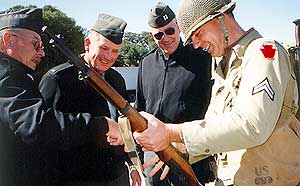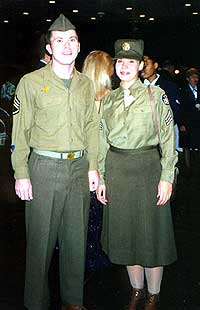Dedicated collector keeps past alive with authentic
vintage military uniforms
By Terry Boyd,
Stars and Stripes

Photos
courtesy of Lt. Col. Dave Shultz
Shultz, left, says he brings the past
back to life by outfitting re-enactments with his World
War II-era collection of uniforms and equipment.
|
Like a lot of soldiers, airmen and sailors, David Shultz
started wearing military uniforms while running around the
neighborhood playing war with a toy World War II Tommy gun.
His dad’s Army Air Corps bomber-pilot gear from WWII provided
a touch of reality.
Now as an Air Force lieutenant colonel, Shultz is a real
warrior. But unlike most of his contemporaries, Shultz still
has his late father’s flight jacket and more. Lots more. Boxes
more. Rooms more. More than 200 complete American uniforms,
not to mention thousands of pieces of miscellaneous equipment.
In 20 years of collecting, Shultz, the new support flight
commander for the 425th Air Base Squadron, figures that he has
acquired $50,000 to $60,000 worth of equipment — every sort
you can imagine aside from weapons.
He, wife Sonya, and part of his collection arrived in
Izmir, Turkey, in June. Although he shipped only a small
portion to his small apartment, he still brought a
massive
array of Army and Air Force pieces ranging from officers’ hats
to trench shovels, and uniforms in every kind of fabric from
scratchy wool to supple, elegant herringbone cotton. He could
do what he calls “a reasonable exhibit” with 20 people in 30
or 40 different uniforms with gear — exhibits that he hopes to
do during air shows or veterans ceremonies at European bases.

Shultz, dressed as an American combat
soldier from World War II, shows an M-1 rifle to
modern-day Air Force officers during a re-enactment.
|
In the grand scheme of things, his collection is modest,
Shultz says. After all, the well-heeled can collect tanks and
warplanes. What makes Shultz’s unique is that he’s taken his
collection to thousands of people, doing shows all over the
United States and in parts of Europe, said Air Force Maj. Neal
Vickery, a fellow collector, show collaborator and Shultz’s
friend since college. He is now stationed at Schriever Air
Base in Colorado Springs, Colo.
“His motive is to get this stuff on people,” to show crowds
at veterans reunions, air shows and increasingly popular
battle reenactments how soldiers really looked, Vickery said.
He said Shultz is not just preserving history, but bringing it
back to life.
“If you don’t show it, to me, you shouldn’t collect it to
start with,” says Shultz, shaking his head over museums that
simply warehouse donations of old uniforms and equipment.

Entertainers from a U.S. Air Forces
Europe musical about the Berlin Airlift model wardrobes
provided by Shultz. |
Vickery said that while growing up in the ’60s, he and
Shultz “were deeply affected” by the comic books, movies and
radio programs “that celebrated the guys who had the toughest
jobs.” That included Shultz’s father, Eugene, who was a pilot
with the 381st Bomber Group that flew out of Britain. German
anti-aircraft shot down his father in 1944 on his 17th
mission, and he spent a year as a German prisoner of war.
Surviving his travails, he returned to the Army Air Corps,
retiring as an Air Force colonel after aviators became a
separate service in 1947.
“We knew those people. We grew up with them,” Vickery said.
“We knew their moral character. How they were willing to
sacrifice their lives.”
Shultz said that his epiphany came when he saw the 1977
movie “A Bridge Too Far” about the ill-fated 1944 Market
Garden attack on strategic bridges in the Netherlands. “All
those guys were so courageous, and what they accomplished
under terrible conditions was simply unbelievable,” he said.
So inspired, Shultz began his collection with a uniform
from the 82nd Airborne Division, just after graduating from
Texas Tech University in 1978. Now after 23 years of research
into American uniforms, little details drive him crazy.
Spotting a modern pair of aviator’s wings — nearly identical
to the original — on one of his World War II pilot jackets, he
stopped, said, “Wait a minute. This isn’t right,” and then
produced the authentic wings.

Shultz and Vickery portray World War
II infantry soldiers during a 1998 battle re-enactment.
|
The 45-year-old Shultz said he will not indulge in the
incredibly lucrative collecting of German or Japanese
uniforms. Only American stuff.
“I’m a patriotic guy, and the enemy was the enemy,” he
says. And to this day, Shultz asserts, no generation of
American fighting men and women dressed as well, as
practically or as distinctively as the World War II fighters.
It’s a view shaped somewhat by his father.
The daily uniform that his father wore as a B-17 pilot —
called pinks and greens —“was the sharpest uniform that the
military ever had,” Shultz says. The uniform got its name from
its dark olive, almost chocolate, jacket over grayish trousers
with slight pinkish hue. When the Air Force became a separate
service and adopted blue uniforms, his father hated the
change, especially the early, circa 1950 “Shade 84” uniforms.
“My dad said they made you look like a Greyhound bus driver,”
Shultz says.
Shultz’s collection covers a relatively brief period, from
the early 1940s into Vietnam. But during that time, especially
World War II, the Army alone had dozens of uniforms.
Paratroops had different gear than tankers, infantrymen
different than aviators. “I would be surprised to find one
person who has all the uniforms of combat and regular duty.
And test uniforms,” Shultz says.

Maj. Neal Vickery, right, and Shultz
suit up in authentic World War II bomber gear during a
1998 Air Force open house at Lackland Air Force Base,
Texas. |
And though he owns some of the rarest — including a “Jungle
Jim” tropical Air Force uniform with shorts and a pith helmet
from around 1959 — he doesn’t have everything. He lusts after
the jumpsuit worn by paratroops on D-Day, a uniform made for
that mission only. But it’s
expensive: the helmet, jacket,
pants and the original brown jump boots go for $2,000, mint
condition and un-issued, according to Shultz.
Shultz always has had a fetish for never-issued “mint
condition” gear, Vickery said. “I have as much stuff, but not
as good,” he said.
Collecting top-drawer goods has proved to be financially
wise because millions of pieces of uniforms and equipment have
been thrown away since the 1940s. That shrinking supply
coupled with skyrocketing demand by collectors and reenactors
over the past 10 years has quadrupled prices, say Shultz and
Vickery. Simple backpacks that cost $7 originally now bring
$50. Ammo belts that once went for $15 sell for $80 or $90.
And some of the stuff you might think is worthless might be a
collector’s fantasy. Underwear, for example, is nearly
impossible to find, Shultz says. But he would never sell, he
added.

Lt. Col. David Shultz portrays a
World War II infantry soldier using a uniform and
equipment from his extensive collection. Shultz has
collected U.S. gear from World War II and the postwar
era for more than 20 years.
|
He and Vickery both haunt secondhand stores, looking for
big finds. Rising values means that collectors — especially
Japanese and European collectors — have stripped bare most
Army surplus stores.
One of the biggest thrills the pair have had was finding a
box of World War II uniform buttons in Colorado Springs. “It
was like finding a mother lode,” Vickery said. It primed their
dreams of finding “the huge, dusty government warehouse… with
a case of everything,” he said, laughing.
Until he and Vickery find that warehouse, Shultz said he
can’t put on shows without the
donations from people
around the world. And he’s looking for more. He makes his
pitch “to anyone in the U.S. military between the 1940s and
1960s, ‘If you want to find good home for their stuff …’
He and Vickery do not charge others for the use of their
collections: Shultz says he asks only to be reimbursed for
shipping and dry cleaning.
In the process of showing and collecting, the pair have
gotten to hear the stories of countless men who wore the
uniforms they collect, Vickery said. “We like to hear about
just the simple stuff, the guy who was a cook in motor pool. I
want to hear that story too.”
In the process, old warriors will often open up to him and
Shultz as they never have before. “Family members’ eyes will
get big, and they’ll turn around and say, ‘You never told us
that.’ And that’s a collector’s art, too! That’s what you live
for.”
|
